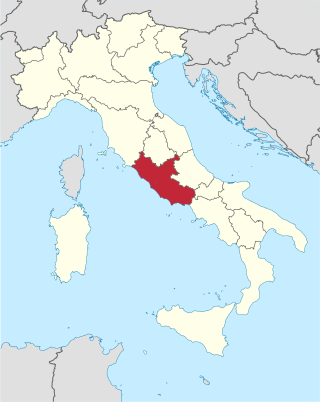
Lazio or Latium is one of the 20 administrative regions of Italy. Situated in the central peninsular section of the country, it has 5,714,882 inhabitants and a GDP of more than €197 billion per year, making it the country's second most populated region and second largest regional economy after Lombardy. The capital of Lazio is Rome, which is also the capital and largest city of Italy.
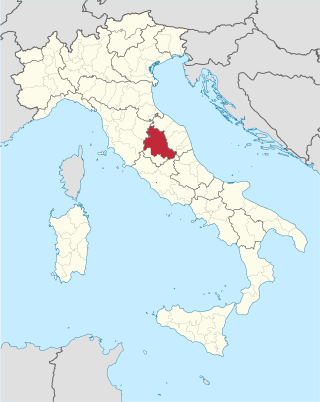
The province of Perugia is the larger of the two provinces in the Umbria region of Italy, comprising two-thirds of both the area and population of the region. Its capital is the city of Perugia. The province covered all of Umbria until 1927, when the province of Terni was carved out of its southern third. The province of Perugia has an area of 6,334 km2 covering two-thirds of Umbria, and a total population of about 660,000. There are 59 comuni in the province. The province has numerous tourist attractions, especially artistic and historical ones, and is home to the Lake Trasimeno, the largest lake of Central Italy. It is historically the ancestral origin of the Umbri, while later it was a Roman province and then part of the Papal States until the late 19th century.

Rome was a department of the First French Empire in present-day Italy. Its principal city was Rome. It was formed on 17 May 1809, when the Papal States were annexed by France, and was first known as the Département du Tibre before being renamed on 17 February 1810. Following the conquest of the Eternal City, Napoleon granted to his son Napoleon II the title of the King of Rome.
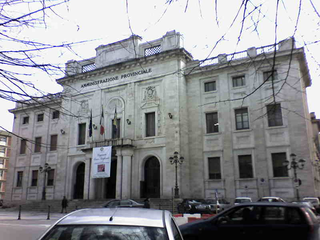
The province of Frosinone is a province in the Lazio region of Italy. Its capital is the city of Frosinone. It has an area of 3,247 square kilometres (1,254 sq mi) and a total population of 493,605 (2016). The province contains 91 comuni, listed in the comuni of the province of Frosinone.
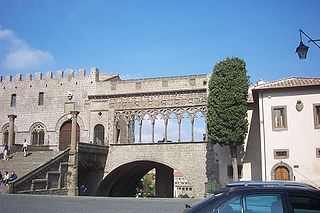
The province of Viterbo is a province in the Lazio region of Italy. Its capital is the city of Viterbo.
The music of Sicily is created by peoples from the isle of Sicily. It was shaped by the island's history, from the island's great presence as part of Magna Grecia 2,500 years ago, through various historical incarnations as a part of the Roman Empire, then as an independent state as the Emirate of Sicily then as an integral part of the Kingdom of Sicily and later the Kingdom of the Two Sicilies, and, finally, as an autonomous region of the modern nation state of Italy.
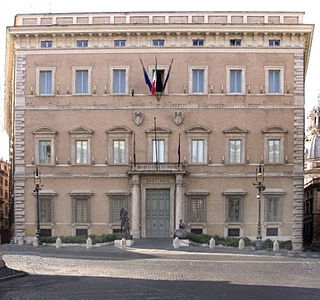
The province of Rome was one of the five provinces that formed part of the Lazio region of Italy. It was established in 1870 and disestablished in 2014. It was essentially coterminous with the Rome metropolitan area. The city of Rome was the provincial capital. During the 1920s, the boundary of the province shrank as land was ceded to establish new provinces. The province of Rome was the most populous province in Italy. On 1 January 2015, it was superseded by a new local government body—the Metropolitan City of Rome Capital.
The Piedmont has played an important role in the development of music, in general, in Italy, due to the presence of medieval monasteries in that area, institutions that were great preservers of manuscripts in the Middle Ages as well as being geographically well located to connect to musical influences from northern Europe. As well, the political dominance of the Royal House of Savoy leading up to its eventual installation as the ruling dynasty of united Italy was important.
The culture of music in Rome is intensely active. The venues for live music include:
The Music of Abruzzo is a style of music in Abruzzo, Italy. Abruzzo is sparsely populated and is very mountainous, but the area has a musical history involving opera, sacred music, and even the town band. The great composer of delicate, 19th-century airs, Francesco Paolo Tosti, dedicated a series of compositions to the area, the romanze abruzzesi.
The music of Trentino-Alto Adige/Südtirol reflects the multilingual and multiethnic make-up of the region. The strong traditions of choral singing, village bands, and folk music are nurtured both by the Italian and German speakers of the area.
Besides Milan, the region of Lombardy has 10 other provinces, each named for the largest city and capital of the respective province: Bergamo, Brescia, Como, Cremona, Lecco, Lodi, Mantova, Pavia, Sondrio, and Varese. Musically, they offer:

Latium is the region of central western Italy in which the city of Rome was founded and grew to be the capital city of the Roman Empire.

Latina is the main railway station of the Italian city of Latina, in the region of Lazio. It is owned by the Ferrovie dello Stato, the national rail company of Italy, and is an important train station of its region.
The Italo-Dalmatian languages, or Central Romance languages, are a group of Romance languages spoken in Italy, Corsica (France), and formerly in Dalmatia (Croatia).
Radio Globo is an Italian popular radio station based in Rome. Despite its name, this radio station is not endorsed or affiliated with Rede Globo.

The Teatro Flavio Vespasiano is the main theatre and opera house in Rieti. It was opened on 20 September 1893, after ten years of work and finishing touches; directed by architect Achille Sfondrini. It takes its name from the Roman emperor Titus Flavius Vespasian who was born in sabina.

The flag of Lazio is one of the symbols of the region of Lazio, Italy. The flag is currently only de facto official, but is in common use.
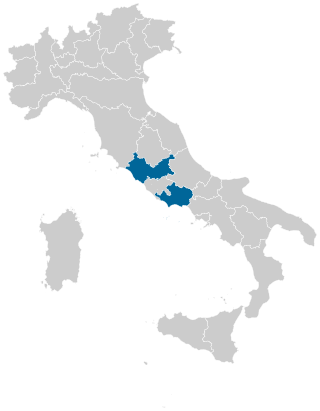
Lazio 2 is one of the 29 constituencies represented in the Chamber of Deputies, the lower house of the Italian parliament. The constituency currently elects 20 deputies. Its boundaries correspond to those of the provinces of Frosinone, Latina, Rieti and Viterbo, within the Lazio region. The electoral system uses a parallel voting system, which act as a mixed system, with 37% of seats allocated using a first-past-the-post electoral system and 61% using a proportional method, with one round of voting.
(Much of the information on the musical activities, theaters and other venues for music in this region is taken from Guide Cultura, i luoghi della music (2003), ed. Touring Club Italiano.)










